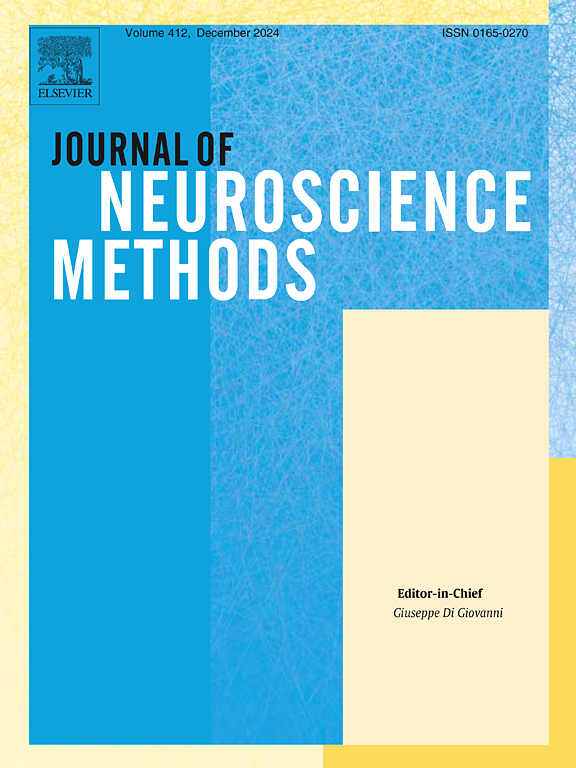Electrode configurations for sensitive and specific detection of compound muscle action potentials to the tibialis anterior muscle after peroneal nerve injury in rats
IF 2.3
4区 医学
Q2 BIOCHEMICAL RESEARCH METHODS
引用次数: 0
Abstract
Background
Quantifying peripheral nerve regeneration via electrophysiology is a commonly used technique, but it can be complicated by spurious electrical activity. This study sought to compare electrode configurations for measuring compound muscle action potential (CMAP) of the tibialis anterior (TA) muscle in a rat model for specific and sensitive detection of regeneration of peroneal nerve to the TA.
New method
10 Sprague-Dawley rats underwent a peroneal nerve transection with direct microsuture repair. CMAPs were conducted with different placements and types of electrodes. Compound action potentials (CAPs) and gait analysis were regularly collected up to 70 days (d) post operation (PO). Nerve sections were harvested at 49 d (n = 4) and 70 d (n = 6) PO and stained with toluidine blue to assess nerve morphometry.
Results
Of the tested configurations for CMAPs, a concentric recording/reference electrode in combination with stimulation from the sciatic notch showed the least background and highest sensitivity, while some configurations showed significant noise and did not detect changes in CMAPs within the 70 d recording period following injury. CAPs, gait analysis, morphometry, and muscle mass support the extent of regeneration indicated by CMAPs collected with concentric electrodes.
Conclusion
Collateral innervation patterns can complicate CMAP recordings as signals from adjacent muscles can be detected and misinterpreted as regeneration. The outcome of this study shows how differences in configurations and electrodes have significant effects on CMAP for the TA. The results identify methods using concentric electrodes that provide high specificity and sensitivity capable of detecting evidence of regeneration early after injury.
大鼠腓神经损伤后胫骨前肌复合肌动作电位敏感特异检测的电极配置。
背景:通过电生理学量化周围神经再生是一种常用的技术,但它可能会因虚假的电活动而复杂化。本研究旨在比较测量大鼠胫骨前肌(TA)复合肌动作电位(CMAP)的电极配置,以特异性和敏感地检测腓神经向TA的再生。新方法:10只Sprague-Dawley大鼠腓神经横断直接微缝线修复。采用不同位置和类型的电极进行cmap。术后70天定期收集复合动作电位(CAPs)和步态分析。在第49天(n=4)和第70天(n=6)采集神经切片,用甲苯胺蓝染色评估神经形态学。结果:在CMAPs的测试配置中,同心圆记录/参考电极结合坐骨切迹刺激显示出最低的背景和最高的灵敏度,而一些配置显示出明显的噪声,并且在损伤后70 d的记录期内未检测到CMAPs的变化。CAPs、步态分析、形态测量和肌肉质量支持同心电极收集的cmap所显示的再生程度。结论:侧支神经支配模式可使CMAP记录复杂化,因为邻近肌肉的信号可被检测到并误解为再生。本研究结果表明,结构和电极的差异对TA的CMAP有显著影响。结果确定了使用同心电极的方法,该方法具有高特异性和灵敏度,能够在损伤后早期检测到再生的证据。
本文章由计算机程序翻译,如有差异,请以英文原文为准。
求助全文
约1分钟内获得全文
求助全文
来源期刊

Journal of Neuroscience Methods
医学-神经科学
CiteScore
7.10
自引率
3.30%
发文量
226
审稿时长
52 days
期刊介绍:
The Journal of Neuroscience Methods publishes papers that describe new methods that are specifically for neuroscience research conducted in invertebrates, vertebrates or in man. Major methodological improvements or important refinements of established neuroscience methods are also considered for publication. The Journal''s Scope includes all aspects of contemporary neuroscience research, including anatomical, behavioural, biochemical, cellular, computational, molecular, invasive and non-invasive imaging, optogenetic, and physiological research investigations.
 求助内容:
求助内容: 应助结果提醒方式:
应助结果提醒方式:


